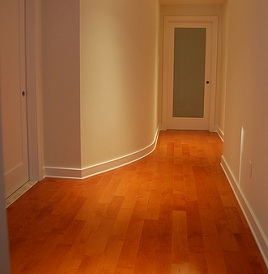
Engineered hardwood floors and solid hardwood floors have the wood itself in common, but that’s where the similarities in their compositions end. While the composition of engineered hardwood floors allow it to be used in virtually any application, solid hardwood floors are generally limited to areas that have a very even, moderate temperature and humidity level.
Engineered Hardwood vs. Solid Hardwood Maintenance As far as caring for the two, the maintenance of hardwood floors is about the same as that of engineered hardwood floors. Follow the same cleaning procedures for both, and always refer to the manufacturer’s instructions before using any flooring products on either. Now let’s explore what makes these two similar looking flooring materials so different from one another.
Differences in Solid and Engineered Hardwood Composition Solid wood is milled from a real hardwood species, making it the sole material used in the making of the flooring. It may be cut at different widths and lengths to create a more dimensional floor. Engineered hardwood is actually produced with three or more layers of HDF, MDF, with a real hardwood veneer bonded together under heat and pressure. Both options give the look of real wood since both are made from real wood. The difference is that engineered hardwood flooring only contains a small amount where solid wood is, well, solid. Differences in Strength and Uniformity of Solid and Engineered Hardwood Solid hardwood flooring is noted for adding overall structural strength to the building in which it is installed. The degree to which this is true depends upon the species. Homeowners may refer to the Janka hardness scale to find out which species provide greater strength. Red Oak is the industry benchmark for comparison.
Engineered hardwood flooring, on the other hand, is more suitable in high-moisture areas or in areas of frequent temperature changes than solid hardwood due to its “multiple-ply plank” manufacturing. It is more flexible than solid hardwood floors, creating a different kind of strength for the structure.
The uniformity of solid wood varies depending on grade. Some grades allow for multiple knots, for example. Engineered hardwood is designed for optimal uniformity. It is also worth noting that engineered bamboo flooring is another option to provide even more flexibility in design.
Differences in Dimensional Stability and Moisture and Heat Resistance Solid hardwoods are prone to expansion, warping, cupping, to a significant degree when exposed to temperature changes. Solid wood is unsuitable for applications at any location with increased moisture or high temperatures. These could be areas which are not environmentally controlled, damp areas such as below-grade installations and over radiant heat. Solid wood generally expands and contracts a lot more than engineered wood during climatic changes, especially extremes in heat and cold and rainy season.
Engineered hardwoods are constructed to be more dimensionally stable through multi-ply design. This allows greater resistance to temperature changes. Engineered hardwood is surely a suitable choice when solid wood is not applicable due to increased moisture or heat. It is more resistant to both if compared to solid wood.
Engineered hardwood does not warp or cup during climatic changes. It is more resistant to higher moisture levels than solid flooring. It is a better choice for installation over radiant heat sources, damp basements, and at locations in rainy climates. Overall, engineered flooring gives you more options for installation with wood without having to resort to vinyl flooring or laminate.





